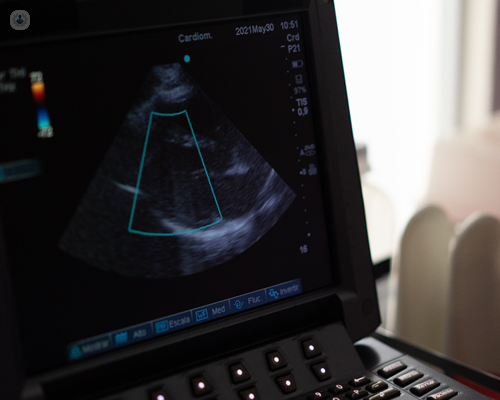Role of ultrasound-guided interventions in modern medicine: Minimally invasive, highly effective
Escrito por:Ultrasound-guided interventions have become an integral part of modern medicine, offering a minimally invasive, precise, and effective approach to diagnosing and treating a wide range of conditions. By utilising real-time imaging, these procedures enhance accuracy, minimise complications, and significantly improve patient outcomes. This article explores the role of ultrasound-guided interventions, their benefits, and how they have transformed various areas of healthcare.

What are ultrasound-guided interventions?
Ultrasound-guided interventions involve the use of ultrasound technology to visualise internal organs and structures in real-time while performing diagnostic or therapeutic procedures. The ultrasound equipment sends high-frequency sound waves into the body, creating detailed images that allow healthcare professionals to precisely guide instruments, such as needles or catheters, to the targeted area.
How are ultrasound-guided interventions used in medicine?
Ultrasound-guided interventions are used across many fields of medicine, from pain management and oncology to musculoskeletal and vascular treatments. Some common applications include:
- Biopsies: Ultrasound guidance helps locate tumours or abnormal growths to obtain tissue samples for diagnostic purposes, ensuring accuracy while reducing the need for larger incisions.
- Joint injections: In conditions like arthritis or tendinitis, ultrasound guidance allows for precise placement of steroid or other therapeutic injections into joints or tendons to reduce inflammation and pain.
- Drainage of fluid collections: In cases of abscesses or fluid build-up (e.g., pleural effusion), ultrasound can be used to guide the placement of a drainage catheter with minimal discomfort and lower risk of complications.
- Pain management: In chronic pain conditions, such as nerve pain or spine-related issues, ultrasound guidance enables the precise delivery of nerve blocks or other injections, reducing pain and improving patient outcomes.
- Vascular access: Ultrasound is commonly used to guide the insertion of central lines, ensuring the needle is placed correctly into veins, reducing the risk of puncturing arteries or surrounding structures.
What are the benefits of ultrasound-guided interventions?
The adoption of ultrasound guidance has provided a wide range of benefits for patients and clinicians alike:
- Minimally invasive: As these procedures are often performed with minimal incisions or small needles, patients experience less pain, faster recovery, and a reduced risk of infection compared to traditional surgery.
- Real-time imaging: Ultrasound offers continuous imaging, enabling clinicians to make immediate adjustments to the procedure based on real-time visual feedback, thus improving accuracy.
- Reduced radiation exposure: Unlike procedures that rely on X-rays or CT scans for guidance, ultrasound uses sound waves, meaning patients are not exposed to ionising radiation, making it a safer option, particularly for pregnant women and children.
- Cost-effective: Ultrasound equipment is generally more affordable than other imaging technologies like MRI or CT, which can make guided procedures more accessible and cost-effective for healthcare providers and patients.
- Faster recovery: The minimally invasive nature of ultrasound-guided interventions typically leads to quicker recovery times, allowing patients to return to their normal activities sooner.
Are there any risks associated with ultrasound-guided interventions?
Although ultrasound-guided interventions are generally considered safe and effective, as with any medical procedure, there are some potential risks. These may include infection, bleeding, or unintended injury to nearby structures. However, the use of real-time imaging significantly reduces these risks by improving accuracy and precision.
Patients should always discuss any concerns or potential risks with their healthcare provider before undergoing a procedure. The benefits of ultrasound-guided interventions often outweigh the risks, particularly when compared to more invasive alternatives.
In which medical fields are ultrasound-guided interventions most effective?
Ultrasound-guided procedures have proven effective in several key areas of healthcare, including:
- Musculoskeletal conditions: These interventions are widely used in diagnosing and treating conditions like joint pain, tendonitis, and soft tissue injuries, providing pain relief and improving function.
- Oncology: Ultrasound is frequently used to guide biopsies or therapeutic procedures in cancer treatment, such as draining malignant fluid collections or targeting tumours for ablation therapies.
- Gastroenterology: Ultrasound guidance is used for procedures such as liver biopsies or draining fluid collections in the abdomen, improving accuracy and reducing the risks associated with invasive procedures.
- Cardiology: Ultrasound-guided vascular access is essential for safely inserting catheters or lines into blood vessels during treatments for heart conditions, such as pacemaker insertion or stent placement.
Ultrasound-guided interventions have transformed modern medicine by offering a minimally invasive, highly effective way to diagnose and treat a variety of conditions. From guiding joint injections to aiding in cancer biopsies, these procedures allow for greater precision and reduced risks, leading to improved patient outcomes. As technology continues to advance, ultrasound-guided interventions will likely play an even more prominent role in healthcare, offering patients safer and more efficient treatment options.


